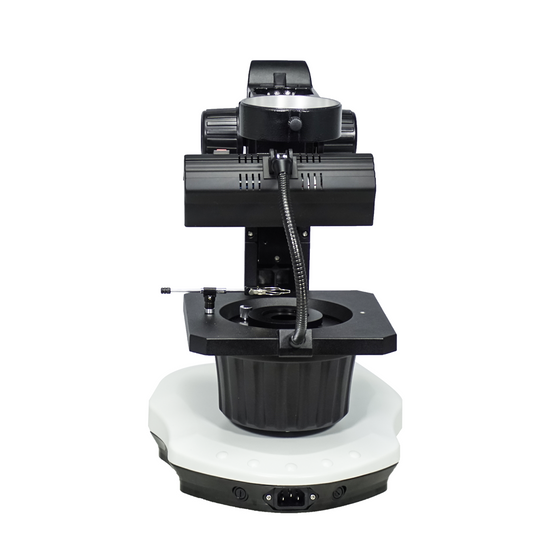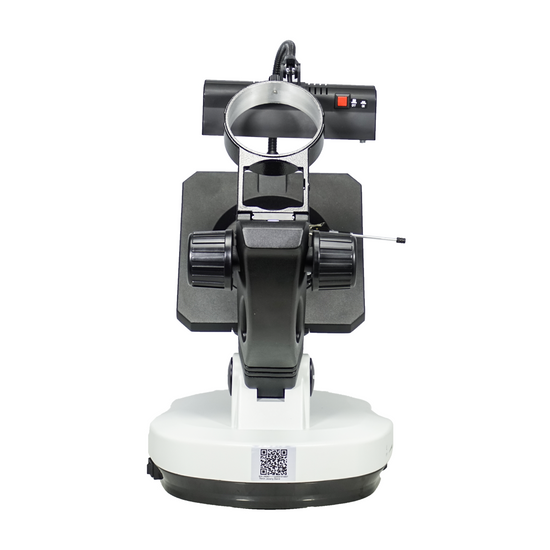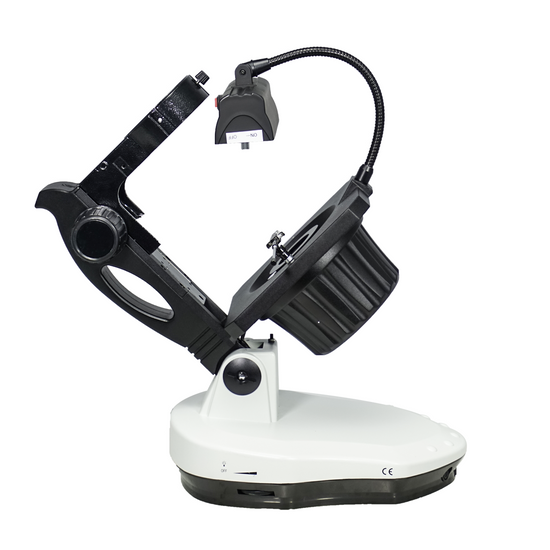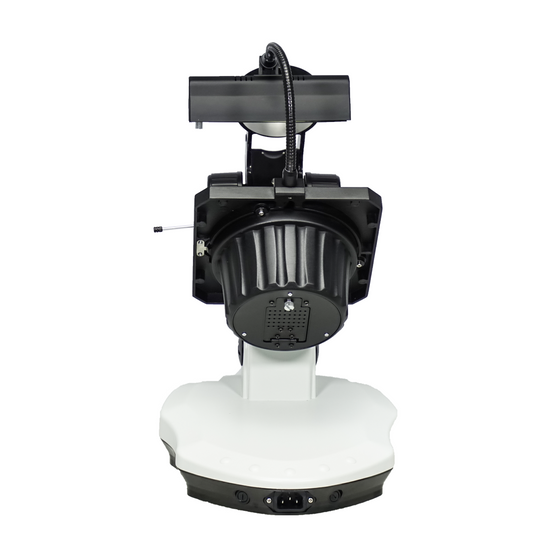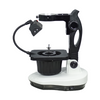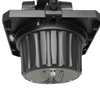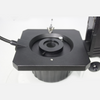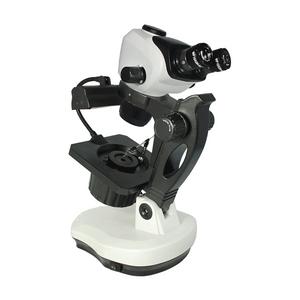Quick Overview
Jewelry Stand. Dia. 84.5mm Scope Holder . Track Length: 250mm. Base Dimensions: 310x250x70mm. 360° Degree Rotatable. Inclination on Vertical Direction: 0-45° . Microscope Handle: Yes. Focus Distance: 110mm. Illumination Type: FH Dual Illuminated Light. Top Illumination: Oblique Top Light. Bottom Illumination: Bright/Dark Field. Output Power: 30W. Input Voltage: AC 110-220V 50/60Hz. Output Voltage: DC 6V. Power Cord Connector Type: USA 3 Pins.
JM02011115 84.5mm Jewelry Stand
Jewelry Stand
| Stand Type | Jewelry Stand |
| Holder Adapter Type | Dia. 84.5mm Scope Holder |
| Track Length | 250mm |
| Base Type | Illumination Base |
| Stand Throat Depth | 129mm |
| Base Dimensions | 310x250x70mm |
| Base Rotatable | 360° Degree Rotatable |
| Inclination on Vertical Direction | 0-45° |
| Microscope Handle | Yes |
| Focus Mode | Manual |
| Focus Distance | 110mm |
| Coarse Focus Distance per Rotation | 21mm |
| Focusing Knob Tightness Adjustable | Tightness Adjustable |
| Illumination Type | FH Dual Illuminated Light |
| Top Illumination | Oblique Top Light |
| Top Illumination Type | Fluorescent Light |
| Bottom Illumination | Bright/Dark Field |
| Bottom Illumination Type | Halogen Light |
| Aperture Diaphragm | Aperture Diaphragm Adjustable |
| Aperture Diaphragm Mounting Position | Vertical Illuminator |
| Field Diaphragm Outer Diameter | Dia. 70mm |
| Output Power | 30W |
| Input Voltage | AC 110-220V 50/60Hz |
| Output Voltage | DC 6V |
| Power Cord Connector Type | USA 3 Pins |
| Power Cable Length | 1.8m |
| Surface Treatment | Electroplating Black |
| Material | Metal |
| Color | Black |
| Net Weight | 6.60kg (14.55lbs) |
| Dimensions | 310x250x390mm (12.205x9.843x15.354 in. ) |
Technical Info
Instructions
Microscope StandClose Λ
| Microscope stand have many options depending on the needs, especially stereo microscope stand, there are several factors to consider before choosing: Stability: microscope stand is used to prop up the microscope body. The stand should be selected according to the size of the microscope mainframe. The stability of the stand determines the stability of the microscope in use, and its various adapters and screws must be tightly locked. Volume size: limited by the working environment and space of the workbench. Workspace and scope: the size of the workspace of the object being observed and the height of the object being observed should be considered. Choice of lighting: some stands are equipped with a light source, but some are not, depending on whether there are conditions to add additional lighting. Operational requirements: 1. Install the stand as required. 2. Arrange a reasonable fixed position for the stand. 3. Carefully tighten the microscope mainframe. 4. Arrange the location of the additional light source reasonably, and place the electric wire in a position that does not interfere with the work. 5. Connect the various kinds of peripheral devices, such as cameras, monitors, computers and so on. |
Jewelry StandClose Λ
| Jewelry microscope stand is a special stand designed to detect jewelry, diamonds, etc. A jewelry stand is usually equipped with the following several light sources and devices: Upper light source has both natural light of a halogen lamp and fluorescent lamp. The fluorescent lamp is usually a "full-wave band" fluorescent lamp. The use of a natural light with continuous wave band can ensure the effect of observing jewelry and diamonds, and is consistent with the effect color seen under daylight. Lower light source: diffuse reflection light with dark field equipment is often used, and some advanced stand are also equipped with iris diaphragm. Uniform illumination can eliminate reflection and stray light to facilitate observation of details of the jewelry or diamond. Jewelry clips are used to clip or clamp jewels and diamonds. |
Illumination BaseClose Λ
| Illumination base is a modular light source component, suitable for microscope stand base that has no light source of itself, and it is usually dedicated components supporting some stands. Illumination base typically includes at least one bottom lighting, and there are also illumination base that includes the circuit portion of the upper light source. |
Stand Throat DepthClose Λ
| Stand throat depth, also known as the throat depth, is an important parameter when selecting a microscope stand. When observing a relatively large object, a relatively large space is required, and a large throat depth can accommodate the object to move to the microscope observation center. |
360° Degree RotatableClose Λ
| The eyepiece of the microscope can have different viewing or observing directions. When the position of the microscope is uncomfortable, the direction of the eyepiece tube of the microscope can be adjusted, to facilitate observation and operation. Placement method of different viewing angles of the microscope: General direction: the support column is behind the object to be observed Reverse direction: the support column is in front of the object to be observed Lateral direction: the support column is on the side of the object to be observed Rotating eyepiece tube, different microscopes may have different methods, for some, the direction is confirmed when installing the eyepiece tube of the microscope, for some, by rotating the body of the microscope, and for some, by rotating the support member on the support or holder of the microscope. |
Inclination on Vertical DirectionClose Λ
| Conventional microscopic observation is to observe the observed object from top to bottom at a vertical angle of 90 degrees. Inclination on vertical direction observation is to observe from an angle of inclination direction based on the needs of the object to be observed, so as to see more suitable feature points of the observed object. Inclination observation often has ergonomic requirements that allow the observer to adjust the angle at will, and using the microscope in a more comfortable position and sitting posture can help reduce fatigue. In general, all inclination observations are to use microscope with low magnification, which requires a larger field of view and depth of field, otherwise the focusing will be more difficult. |
Focusing Knob Tightness AdjustableClose Λ
| Different microscope bodies, different human operations, and different requirements for observation and operation, all require adjustment of the pre-tightening force of the stand that support microscope body. Facing the stand just right, use both hands to reverse the force to adjust the tightness. (face the knob of one side just right, clockwise is to tighten, counterclockwise is to loosen) In general, after long-time use, the knob will be loose, and adjustment is necessary. |
Aperture DiaphragmClose Λ
| The diaphragm that determines the image plane necessary for imaging through the objective lens is called the aperture diaphragm. All irises of the traditional microscope are aperture diaphragm. The function of aperture diaphragm is mainly to limit the size of the imaging beam, change the luminous flux, thereby improving the imaging quality. The size of the aperture diaphragm is usually variable, and it is also called iris diaphragm. When the aperture diaphragm lock is too small and the luminous flux of the imaging beam is insufficient, the fraction ratio of the objective lens is low, the imaging will become dark; however, when the aperture diaphragm is too large, there will be strong light in the field of view, and even though viewed from the eyepiece, it may have high resolution, the image on the display will be overexposed. After replacing the objective lens, the aperture diaphragm should also be adjusted appropriately, rather than adjusting the brightness of the light. The aperture diaphragm of the transmitted light is generally mounted on the microscope base. The aperture diaphragm of the biological microscope is mounted on the condenser device. On the other hand, the aperture diaphragm of compound microscopes, such as large upright metallurgical or fluorescence microscopes, is generally mounted on the in the coaxial reflection illuminator. In the use of the aperture diaphragm, it is often necessary to adjust the center of the diaphragm. Generally, it is adjusted together with the condenser. Please refer to the adjustment method of the condenser. |
PackagingClose Λ
| After unpacking, carefully inspect the various random accessories and parts in the package to avoid omissions. In order to save space and ensure safety of components, some components will be placed outside the inner packaging box, so be careful of their inspection. For special packaging, it is generally after opening the box, all packaging boxes, protective foam, plastic bags should be kept for a period of time. If there is a problem during the return period, you can return or exchange the original. After the return period (usually 10-30 days, according to the manufacturer’s Instruction of Terms of Service), these packaging boxes may be disposed of if there is no problem. |
| Packing | |
| Packaging Type | Carton Packaging |
| Packaging Material | Corrugated Carton |
| Packaging Dimensions(1) | 55x33x61cm (21.654x12.992x24.016″) |
| Inner Packing Material | Plastic Bag |
| Ancillary Packaging Materials | Styrofoam |
| Gross Weight | 9.74kg (21.47lbs) |
| Minimum Packaging Quantity | 1pc |
| Transportation Carton | Carton Packaging |
| Transportation Carton Material | Corrugated Carton |
| Transportation Carton Dimensions(1) | 55x33x61cm (21.654x12.992x24.016″) |
| Total Gross Weight of Transportation(kilogram) | 9.74 |
| Total Gross Weight of Transportation(pound) | 21.47 |



